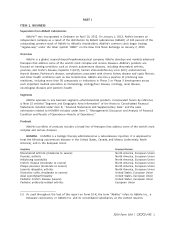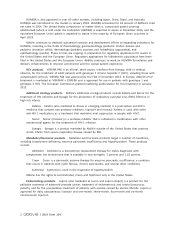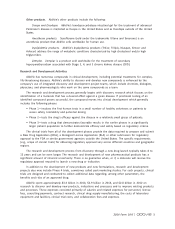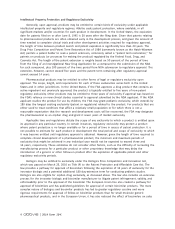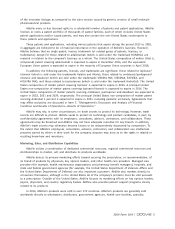AbbVie 2014 Annual Report Download - page 16
Download and view the complete annual report
Please find page 16 of the 2014 AbbVie annual report below. You can navigate through the pages in the report by either clicking on the pages listed below, or by using the keyword search tool below to find specific information within the annual report.
13NOV201221352027
In addition to regulatory initiatives, AbbVie’s business can be affected by ongoing studies of the
utilization, safety, efficacy, and outcomes of health care products and their components that are regularly
conducted by industry participants, government agencies, and others. These studies can call into question
the utilization, safety, and efficacy of previously marketed products. In some cases, these studies have
resulted, and may in the future result, in the discontinuance of, or limitations on, marketing of such
products domestically or worldwide, and may give rise to claims for damages from persons who believe
they have been injured as a result of their use.
Access to human health care products continues to be a subject of investigation and action by
governmental agencies, legislative bodies, and private organizations in the United States and other
countries. A major focus is cost containment. Efforts to reduce health care costs are also being made in the
private sector, notably by health care payors and providers, which have instituted various cost reduction
and containment measures. AbbVie expects insurers and providers to continue attempts to reduce the cost
of health care products. Outside the United States, many countries control the price of health care products
directly or indirectly, through reimbursement, payment, pricing, coverage limitations, or compulsory
licensing. Budgetary pressures in the United States and in other countries may also heighten the scope and
severity of pricing pressures on AbbVie’s products for the foreseeable future.
United States. Specifically, U.S. federal laws require pharmaceuticals manufacturers to pay certain
statutorily-prescribed rebates to state Medicaid programs on prescription drugs reimbursed under state
Medicaid plans, and the efforts by states to seek additional rebates affect AbbVie’s business. Similarly, the
Veterans Health Care Act of 1992, as a prerequisite to participation in Medicaid and other federal health
care programs, requires that manufacturers extend additional discounts on pharmaceutical products to
various federal agencies, including the United States Department of Veterans Affairs, Department of
Defense, and Public Health Service entities and institutions. In addition, recent legislative changes would
require similarly discounted prices to be offered to TRICARE program beneficiaries. The Veterans Health
Care Act of 1992 also established the 340B drug discount program, which requires pharmaceuticals
manufacturers to provide products at reduced prices to various designated health care entities and facilities.
In the United States, most states also have generic substitution legislation requiring or permitting a
dispensing pharmacist to substitute a different manufacturer’s generic version of a pharmaceutical product
for the one prescribed. In addition, the federal government follows a diagnosis-related group (DRG)
payment system for certain institutional services provided under Medicare or Medicaid and has
implemented a prospective payment system (PPS) for services delivered in hospital outpatient, nursing
home, and home health settings. DRG and PPS entitle a health care facility to a fixed reimbursement based
on the diagnosis and/or procedure rather than actual costs incurred in patient treatment, thereby
increasing the incentive for the facility to limit or control expenditures for many health care products.
Medicare reimburses Part B drugs based on average sales price plus a certain percentage to account for
physician administration costs, which have recently been reduced in the hospital outpatient setting. End
stage renal disease treatment is covered through a bundled payment that likewise creates incentives for
providers to demand lower pharmaceutical prices. Medicare enters into contracts with private plans to
negotiate prices for most patient-administered medicine delivered under Part D.
In March 2010, Congress enacted the Patient Protection and Affordable Care Act and the Health Care
and Education Reconciliation Act (together, the Affordable Care Act). Under the Affordable Care Act, AbbVie
pays a fee related to its pharmaceuticals sales to government programs. Also in 2011, AbbVie began
providing a discount of 50 percent for branded prescription drugs sold to patients who fall into the
Medicare Part D coverage gap, or ‘‘donut hole.’’
The Affordable Care Act also includes provisions known as the Physician Payments Sunshine Act, which
require manufacturers of drugs and biologics covered under Medicare and Medicaid starting in 2012 to
record any transfers of value to physicians and teaching hospitals and to report this data beginning in 2013
to the Centers for Medicare and Medicaid Services for subsequent public disclosure. Similar reporting
10 2014 Form 10-K



